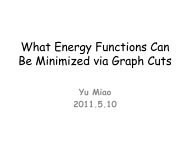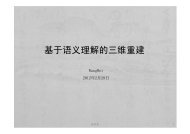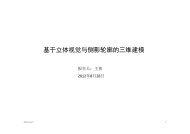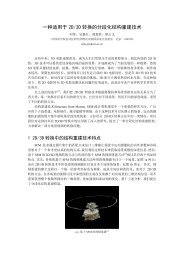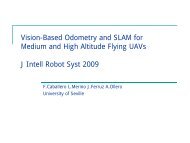Rotationally Invariant Descriptors using Intensity Order ... - IEEE Xplore
Rotationally Invariant Descriptors using Intensity Order ... - IEEE Xplore
Rotationally Invariant Descriptors using Intensity Order ... - IEEE Xplore
You also want an ePaper? Increase the reach of your titles
YUMPU automatically turns print PDFs into web optimized ePapers that Google loves.
This article has been accepted for publication in a future issue of this journal, but has not been fully edited. Content may change prior to final publication.<br />
<strong>IEEE</strong> TRANSACTION ON PATTERN ANALYSIS AND MACHINE INTELLIGENCE 24<br />
3) Performance Evaluation based on 3D Objects: Moreels and Perona [45] evaluated different<br />
combinations of feature detectors and descriptors based on 3D objects. We evaluated the proposed<br />
descriptors following their work 3 . The Hessian-Affine detector was used for feature extraction<br />
since it was reported with the best results combined with SIFT in [45]. As in [45], interest point<br />
matching was conducted on a database containing both the target features and a large amount of<br />
features from unrelated images so as to mimic the process of image retrieval/object recognition.<br />
10 5 features were randomly chosen from 500 unrelated images obtained from Google by typing<br />
’things’. Please refer to [45] for more details about the dataset and experimental setup.<br />
Detection Rate<br />
0.12<br />
0.1<br />
0.08<br />
0.06<br />
0 0.2 0.4 0.6 0.8 1<br />
x 10 −5<br />
0.04<br />
0.02<br />
DAISY<br />
SIFT<br />
MROGH<br />
MRRID<br />
RIFT<br />
0<br />
False Alarm Rate<br />
(a)<br />
Detection Rate<br />
0.09<br />
0.08<br />
0.07<br />
0.06<br />
0.05<br />
0.04<br />
0.03<br />
0.02<br />
0.01<br />
DAISY<br />
SIFT<br />
MROGH<br />
MRRID<br />
RIFT<br />
0<br />
5 10 15 20 25 30 35 40 45<br />
viewpoint changes(camera rotation angle in degrees)<br />
Fig. 13. Experimental results on the dataset of 3D objects. (a) Detection Rate vs. False Alarm Rate; (b) Detection Rate vs.<br />
Viewpoint Changes at false alarm rate of 10 −6 .<br />
Fig. 13 shows the comparative results. In Fig. 13(a), the ROC curves of ’detection rate vs.<br />
false alarm rate’ were obtained by varying the threshold of nearest neighbor distance ratio which<br />
defines a match. The detection rate is the number of detections against the number of tested<br />
matches, while the false alarm rate is the number of false alarms divided by the number of tested<br />
matches. A tested match is classified as a non-match, a false alarm or a correct match (a detection)<br />
according to the distance between their descriptors and whether the geometric constraints are<br />
satisfied or not [45]. In Fig. 13(b), it shows the detection rate as a function of the viewpoint<br />
changes at a fixed false alarm rate. The false alarm rate 10 −6 implies that one false alarm<br />
3<br />
The dataset was downloaded from http://www.vision.caltech.edu/pmoreels/Datasets/TurntableObjects. The downloadable<br />
dataset actually contains 77 different objects, so in our experiments it is 77 different objects used for evaluation not 100<br />
as described in [45].<br />
November 26, 2011 DRAFT<br />
(b)



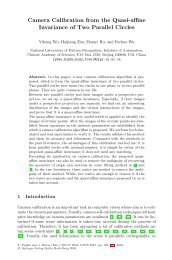
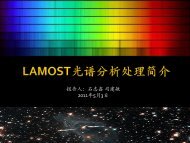
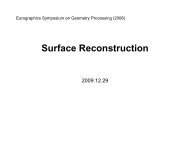
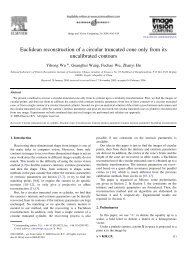
![Accurate, Dense, and Robust Multi-View Stereopsis (PMVS) [1,2,3]](https://img.yumpu.com/19388840/1/190x135/accurate-dense-and-robust-multi-view-stereopsis-pmvs-123.jpg?quality=85)


